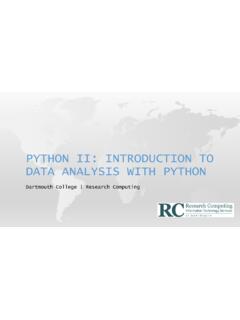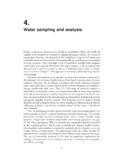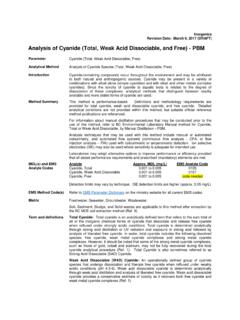Transcription of USING R FOR BASIC SPATIAL ANALYSIS - Dartmouth College
1 Dartmouth College | Research ComputingUSING R FOR BASIC SPATIAL ANALYSIS Research Computing and SPATIAL ANALYSIS at Dartmouth What is SPATIAL ANALYSIS ? What is R? Basics of R Common SPATIAL Packages for R Viewing and analyzing SPATIAL Data in R Hands-on practice Display in GIS software Questions and Wrap-upOVERVIEWRESEARCH COMPUTING AT Dartmouth Research Computing Workshops Storage Consulting Software Hardware Visit our website, Request a research account Email us Promote the advancement of research through the use of high-performance computing (HPC), life sciences support and bioinformatics, GIS consulting, services and workshops Courses in the Geography Department and the Earth Sciences Department, GIS and SPATIAL ANALYSIS Geography Department Geog50 Geographic Information Systems Geog57 Urban Applications of GIS Geog51 / Ears 65: Remote Sensing Geog54 Geovisualization Geog59/Ears 77 Environmental Applications of GIS Dartmouth College Library.
2 Library Reference Research Guides for the R statistical package, GIS and SPATIAL ANALYSIS GIS Statistics, R Research ComputingSPATIAL ANALYSIS AT Dartmouth Data Visualization USING R James Adams, Baker-Berry Library, Statistical Consulting (R, Stata, SAS) JianjunHua from Ed Tech provides consulting support for statistics-related questions. Jianjuncan be contacted at 603-646-6552 or by R for High Performance Computing, parallel computing, GIS R Club Katja Koeppen, Microbiology Department organizes an R Club, Programming n Pizza Departmental Courses at Dartmouth , Statistics, Math, Quantitative Social Sciences, etc Math 10, Math 50 , Math 10, Online Stats book Online Statistics Education: A Multimedia Course of Study ( ). David M. Lane, Rice INFO SPATIAL ANALYSIS is the application of ANALYSIS tools to SPATIAL data SPATIAL data includes geographic data in both raster and vector formats, for example: Vector data points, lines and regions (polygons) Raster data gridded data such as satellite imagery, elevation data across a surface, rainfall totals across a surface over a given period of time WHAT IS SPATIAL ANALYSIS ?
3 R is a free software environment used for computing, graphics and statistics. It comes with a robust programming environment that includes tools for data ANALYSIS , data visualization, statistics, high-performance computing and geographic ANALYSIS . Visit more R has been around for more than 20 years and it has become popular at universities, research labs and federal and state government offices in the last ten years for many applications R consists of base packages but also includes hundreds of add-on packages that greatly extend the capabilities of the programming environment. These capabilities include data manipulation, data visualization and SPATIAL ANALYSIS tools CRAN- SPATIAL is located here: If you are already a GIS user, you ll notice similar commands and techniques, and of course, you ll recognize SPATIAL data when displayed on a map in RWHAT IS R? The R console is a quick, light, multiplatform installBASICS OF R (I)THE R CONSOLE R Studio is cross-platform integrated development environment for R It allows us to save R commands to script files, view variables as we define them, and see output and visualizations directly in the environment It runs on Mac and Windows BASICS OF R (II)WHAT IS R STUDIO?
4 The R Studio IDE-Console-Terminal-Script Editor-Variables-Plots, Graphics, Maps!-Exports-Package import Tidyr Ggplot2 Dpylr xlsx Maps Sp Rgdal ParallelBASICS OF R (III)SOME PACKAGES TO EXTEND R SPATIAL : SP SPATIAL GSTAT geostatistics RGDAL geospatial data abstraction library for R MAPS maps GGMAP extends the plotting of ggplot2 with map data RASTER raster data processing MAPTOOLS map tools SPATSTAT wide range of SPATIAL tools and functions COMMON SPATIAL PACKAGES FOR RVIEWING AND ANALYZING SPATIAL DATA (I) Put a Google base map right in your plot window, overlay SPATIAL data on to the map plot 12 Map overlay & SPATIAL statisticsPackages sp, rgdaland maps can turn your R in to a GIS: read, write and analyze SPATIAL data, map overlayVIEWING AND ANALYZING SPATIAL DATA (I)GEOGRAPHIC INFORMATION ANALYSIS ?setwd Help(setwd) Web Searches Google r set working directory Stack Overflow r set working directory stack overflow HELP IN RREADY TO DIVE IN?
5 We ll use R Studio today so we can see our SPATIAL ANALYSIS and work with R script files Open R Studio In the Console at the greater than symbol, enter: > ( maps ) Continue on in R Studio, entering the following commands: GETTING ("ggmap")library(maps)library(ggmap)visi ted <-c("Boston, MA", "Anchorage, AK") <-geocode(visited) < $ < $latGETTING STARTED# Use the # to add comments to your code # geocode function package ggmap ()map("world", fill=TRUE, col="white", bg="lightblue", ylim=c(-60, 90), mar=c(0,0,0,0))points( , , col="red", pch=16) The geocoded data should now show up in R Studio s plots window, shown on a map of the worldVIEW THE RESULTS Enter the following in to the R Studio command lineMAP A COORDINATE ("ggplot2")library(ggplot2)library(ggmap )# This line is a comment plot in windowmapHanover<-get_map("Hanover, NH", zoom=10)ggmap(mapHanover)mapLatLong<-get _map(location = c(lon= , lat= ))ggmap(mapLatLong) To make R code easier to type in, save and re-use, we can use an R Script file.
6 In R Studio, click File > New File > R ScriptUSING R SCRIPT FILES Here we see the code inside a .R file Code can be run line-by-line USING the Run button in the upper barUSING R SCRIPT FILES Open R Studio (All Programs > R Studio) Downloading the Data: In your browser, type At the DartBoxsite, click the ellipses .. and choose Download Download file Copy the file to a convenient location such as:c:\rworkspace Unzip the file WORKING WITH SPATIAL DATAREADY TO DIVE IN? We ll use R Studio today so we can see our SPATIAL ANALYSIS Data for this session can be downloaded Download file and unzip Copy the file to a Working Directory that R will recognize Use the getwd() and setwd() commands in R, and your computer s file browser (Finder on the Mac, Windows Explorer on the PC)GETTING THE DATA AND R TO WORK TOGETHEROn the PC: getwd()[1] "C:/Users/f002d69/Documents"> setwd("c:/users")> getwd()[1] "c:/users"> On the mac.
7 Getwd()[1] "/Users"> setwd("~/Desktop")> getwd()[1] "/Users/sgaughan/Desktop"MAP OVERLAY, POINT-IN-POLYGON ANALYSIS WITH SP OVER FUNCTION Packages sp , rgdal and maps can turn your R into a GIS Read-Write and Analyze SPATIAL data, perform map overlay ( sp ) ( rgdal ) ( maps )library(sp)library(rgdal)library(maps)# load a csv with latitude and longitude coordinatesbears < (" ")coordinates(bears) <-c("longitude", "latitude")# load a shapefile representing an area parks <-readOGR(".", "10m_us_parks_area")25 MAP OVERLAY, POINT-IN-POLYGON ANALYSIS WITH SP OVER FUNCTION# do some projection work ( function from sp)proj4string(bears) <-proj4string(parks)# Map Overlay! ( ) <-! (over(bears, as(parks, "SpatialPolygons")))# get the desired output statistic, fraction of sightings in parksmean( )26 PLOT THE POINTS AND EXPORT bears$park<-over(bears, parks)$Unit_Name# Put the data on the map in just a few lines!plot(coordinates(bears), type="n")# use the ("world", region="usa", add=TRUE)#.
8 And the (parks, border="green", add=TRUE)points(bears[! , ], pch=1, col="gray")27 PLOT THE POINTS AND EXPORT points(bears[ , ], pch=16, col="red")# Export GIS data or flat-file data (bears, " ", )# Export a GIS format shapefile USING the (bears, ".", "bears-by-park", driver="ESRI Shapefile")28 ADDING A LEGEND AND TITLE# add a legendlegend("topright", cex= ,c("Bear in park", "Bear not in park", "Park boundary"),pch=c(16, 1, NA), lty=c(NA, NA, 1),col=c("red", "grey", "green"), bty="n")# add a title title(expression(paste(italic("Ursusarct os")," sightings with respect to national parks")))29# The # is a comment . No need to type these lines # note: package "sp" might ask to restart your R ("sp") ("rgdal")# import librarieslibrary(gstat)library(sp)librar y(rgdal)INSTALL SPATIAL LIBRARIES GSTAT , SP AND GDAL # load the meusedataset in to the Rstudioenvironmentdata(meuse)# retrieve/set SPATIAL coordcoordinates(meuse) = ~x+y# note: coordinates use projection # EPSG:28992 Amersfoort/RD Netherlands DutchRD# view the first 5 coordinate pairscoordinates(meuse)[1:5,]# plot the zinc concentrations (bubble plot,# high levels with larger circles)bubble(meuse, "zinc", col=c("#00ff0088", "#00ff0088"), main = "zinc concentrations (ppm)") LOAD DATASET IN TO R STUDIO AND PLOT examine the "meuse" dataset, point data set consists of 155 samples of top soil heavy metal concentrations (ppm), along with a number of soil and landscape variables.
9 The samples were collected in a flood plain of the river Meuse, near the village Stein, southern Netherlands, Lat, Longitude# Task 2: distance display# load the ( )class( ) # dataframesummary( )coordinates( ) = ~x+y# convert to spatialpontsdataframeclass( )# set the gridded function to "TRUE", which converts class to SpatialPixelsDataFramegridded( ) = TRUE class( )# clear the plot window ()# plot image of grid USING the distance fieldimage( ["dist"])# add a title to the plottitle("Distance to River (dist), red = 0")DISPLAY THE DISTANCE TO RIVERUSE THE GSTAT PACKAGE FOR THE INVERSE DISTANCE WEIGHTED TOOL# use the gstat"Inverse distance weighted" toollibrary(gstat) <-idw(zinc~1, meuse, )class( ) # spatialPixelsDataFramespplot( [" "], main = "zinc inverse distance weighted interpolations")Inverse Distance Weighting (IDW) is a GIS function that uses a deterministic method for multivariate interpolation with a known scattered set of points.
10 Unknown points are calculated with a weighted average of the values available at the known points. This function can be used to create surfaces and index layers based on discrete observations. Temperature, elevation are examples. Reference: LINEARITY# in the previous plot, it # appears #that measurements #of high concentrations# of zinc are, in general, #closer to the river# lets linearize this: plot(log(zinc)~sqrt(dist), meuse)abline(lm(log(zinc)~sqrt(dist), meuse))LOAD THE LINEAR MODEL AND SUMMARIZE#load the linear model in to an <-lm(log(zinc) ~ sqrt(dist), data=meuse)# show summary of the linear modelsummary( )Residuals:Min 1Q Median 3Q Max Coefficients:Estimate Std. Error t value Pr(>|t|) (Intercept) <2e-16 **sqrt(dist) <2e-16 **---Signif. codes: 0 ** ** * . 1 residual standard error: on 153 degrees of freedomMultiple R-squared: ,Adjusted R-squared: F-statistic: on 1 and 153 DF, p-value: < WITH variogram(log(zinc)~sqrt(dist), meuse) ( , model = vgm(1, "Exp", 300, 1)) krige(log(zinc)~1, meuse, , model = )# the values are INTERPOLATED/ PREDICTED by the original dataset and the kriging function spplot( [" "])Kriging is a multistep GIS surface creation tool.








